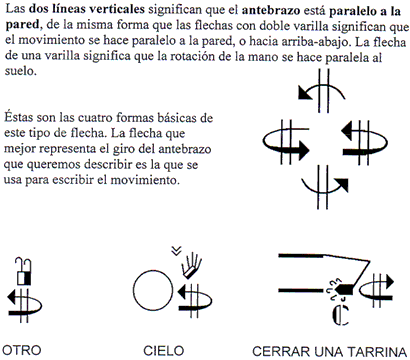| SignWriting List
February 15, 2000
QUESTION 0034:
I find Rotation Symbols difficult.
ANSWER 0034:
Look at the signs in Examples 0034 below, illustrated
by Steve Parkhurst. It is excerpted from the Parkhurst's
new textbook recently published in Spain, entitled "SignoEscritura".
The examples are signs from Spanish Sign Language (Madrid
dialect, is my guess), on page 131 in their book.
It shows the four possible rotations with the double-stemmed
axis.
But it also shows a very interesting sign to the far
right...the sign for "CERRA UNA TARRINA".
I suspect that must mean "unscrewing the lid of
a jar"?
The left hand is the "C" hand, which must be
holding the jar.
The right hand is connected to an arm line, because it
is such an unusual position for the arm to be in....so
the forearm is up and down, parallel with the wall...that
is why the rotation symbol has a
double stem....So where is the rotation movement coming
from? The wrist, in the motion of the arrow....All of
these illustrations have shown "Axial Movement",
which is "rotation of the arm or the wrist":
EXAMPLES 0034

|





































































